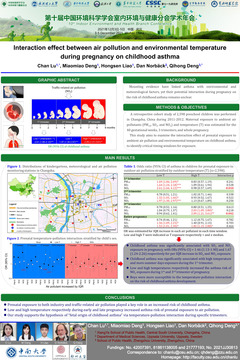[张贴报告]Interaction effect between air pollution and environmental temperature during pregnancy on childhood asthma
Interaction effect between air pollution and environmental temperature during pregnancy on childhood asthma
编号:8
稿件编号:266 访问权限:仅限参会人
更新:2021-09-18 17:23:55 浏览:759次
张贴报告

报告开始:2021年12月05日 17:15 (Asia/Shanghai)
报告时间:1min
所在会议:[P] 墙报 » [PP] 墙报
摘要
Background: Mounting evidence has linked asthma with environmental and meteorological factors, yet any effects due to combined exposure during pregnancy on childhood asthma are unknown.
Objective: To examine the association between asthma and prenatal exposure to both ambient air pollution and temperature, in order to identify any critical time windows for exposure, and their combined effects in asthma development.
Methods: A cohort study of 2,598 preschool children was performed in Changsha, China during the period 2011-2012. A questionnaire was developed to survey each child’s doctor-diagnosed asthma and exposure to home environmental factors. Each mother’s exposure to ambient air pollutants (PM10, SO2, and NO2) and temperature (T) was estimated for the three trimesters and for the whole pregnancy. Associations between asthma and exposure to air pollutants and environmental temperature were assessed using logistic regression models in terms of odds ratio (OR) with 95% confidence interval (CI).
Results: Childhood asthma (6.7%) was significantly associated with exposure to industrial- and traffic-related air pollutants (SO2 and NO2) in utero particularly during the 1st and 2nd trimesters, with ORs (95% CI) = 1.46 (1.13-1.90) and 1.67 (1.24-2.26) respectively for per IQR increase in SO2 and NO2 exposure. Childhood asthma was also positively associated with higher temperature exposure during the 1st trimester, OR (95% CI) = 2.29 (1.09, 4.80) for per IQR increase in T exposure. We also found that exposure to air pollution with low T posed a significantly higher risk compared to exposure at high T during the 1st trimester. Furthermore, asthma risk of exposure to air pollution was significantly higher among children experiencing high T in the 3rd trimester. Sensitivity analysis suggested that boys were more susceptible to the interaction effects between environmental temperature and air pollution on asthma risk.
Conclusion: Prenatal exposure to both low and high temperature, particularly in critical window(s) of pregnancy, exacerbates the effect of prenatal exposure to air pollution on childhood asthma.
Objective: To examine the association between asthma and prenatal exposure to both ambient air pollution and temperature, in order to identify any critical time windows for exposure, and their combined effects in asthma development.
Methods: A cohort study of 2,598 preschool children was performed in Changsha, China during the period 2011-2012. A questionnaire was developed to survey each child’s doctor-diagnosed asthma and exposure to home environmental factors. Each mother’s exposure to ambient air pollutants (PM10, SO2, and NO2) and temperature (T) was estimated for the three trimesters and for the whole pregnancy. Associations between asthma and exposure to air pollutants and environmental temperature were assessed using logistic regression models in terms of odds ratio (OR) with 95% confidence interval (CI).
Results: Childhood asthma (6.7%) was significantly associated with exposure to industrial- and traffic-related air pollutants (SO2 and NO2) in utero particularly during the 1st and 2nd trimesters, with ORs (95% CI) = 1.46 (1.13-1.90) and 1.67 (1.24-2.26) respectively for per IQR increase in SO2 and NO2 exposure. Childhood asthma was also positively associated with higher temperature exposure during the 1st trimester, OR (95% CI) = 2.29 (1.09, 4.80) for per IQR increase in T exposure. We also found that exposure to air pollution with low T posed a significantly higher risk compared to exposure at high T during the 1st trimester. Furthermore, asthma risk of exposure to air pollution was significantly higher among children experiencing high T in the 3rd trimester. Sensitivity analysis suggested that boys were more susceptible to the interaction effects between environmental temperature and air pollution on asthma risk.
Conclusion: Prenatal exposure to both low and high temperature, particularly in critical window(s) of pregnancy, exacerbates the effect of prenatal exposure to air pollution on childhood asthma.
关键字
Childhood asthma; Pregnancy; Trimesters; Ambient air pollution; Environmental temperature; Interaction effect
报告人

.jpg)
发表评论